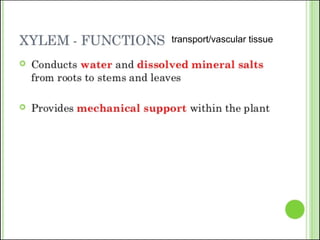
Biology - Plant Transport System.pptx
- 2. Xylem vessels many dead cells protoplasm or end walls to reduce resistance to water flowing hard and rigid substance to prevent the vessel from collapsing
- 3. sucrose&amino acids Sieve Tubes : columns of elongated, thin walled living cells : sieve tube cells or elements. A matured sieve tube cell has a thin layer of cytoplasm in it which is connected to neighbouring cells through the sieve plates. Each sieve tube has lost its central vacuole, nucleus and most organelles. The end walls : sieve plates separating the cells have lots of minute pores Companion cells: narrow, thin walled cell with numerous mitochondria, cytoplasm and a nucleus. Carries out metabolic processes needed to keep the sieve tube cell alive (since it does not have most of its important organelles) and provide nutrients and help the sieve tube cells to transport manufactured food. the energy needed to load sugars from the mesophyll cells into the sieve tubes by active transport rapid flow of
- 4. vascular bundle: arranged in a ring around the pith layer of cells covering the stem; protected by a waxy waterproof cuticle that greatly reduces evaporation of water store up food substances cells can divide and differentiate to form new xylem&phloem tissues
- 5. * * * * * piliferous layer epidermis: outermost layer of cells and bears root hair alternate storage tissue tubular outgrowth of an epidermal cell to increase the surface area to volume ratio of the root hair cell
- 7. enable the body to be cut off; ensures that the proboscis remains in the phloem sieve tube proboscis : sucking part test for sugars: Benedict's test test for amino acids: Biuret test
- 8. accumulation of sugars water potential decreases thus water enters through diffusion
- 11. Entry of Water Each root hair is a fine tubular outgrowth of an epidermal cell containing cell sap which consists of sugar solution thus it has a lower water potential than the soil which causes osmosis to occur. This causes the cell to have a higher water potential thus osmosis happens to the next cell and continues repeatedly throughout the xylem vessels. Entry of ions and mineral salts 1) active transport when the concentration of ions in the soil is lower than the root hair cell ( energy from cellular respiration) 2) diffusion when the concentration is higher Adaptati ons long and narrow increases surface area to volume which increases rate of absorption cell surface membrane prevents the cell sap from leaking which has a lower water potential=osmosis many mitochondria aerobic respiration releases energy for active transport
- 13. flowing upwards lower water potential in xylem vessels
- 14. Water tends to move up inside very narrow tubes due to the interactions between water molecules and the surfaces of the tubes Capillary Tubes
- 16. relatively impermeable to water surfaces of the epidermal cells